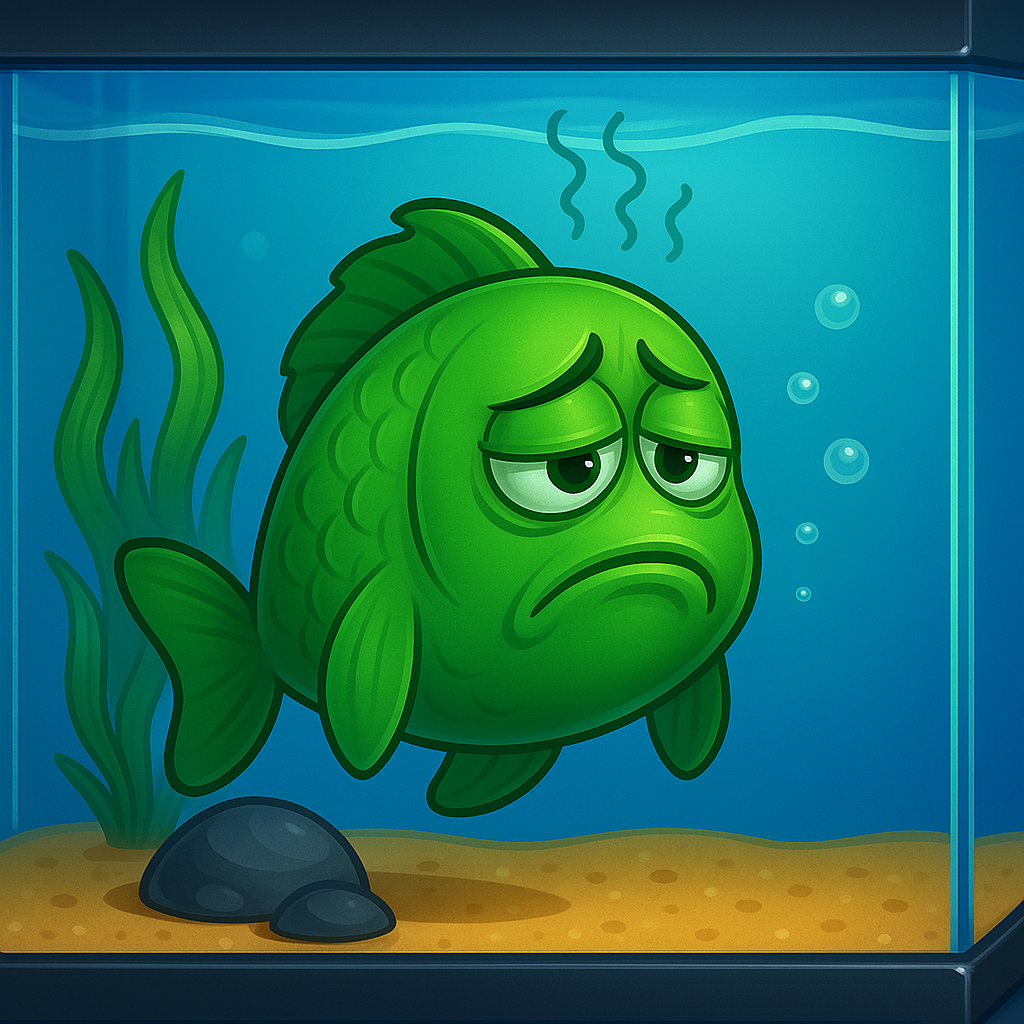Comprehensive Guide: Early Signs of Stress in Aquarium Fish
🐟 Comprehensive Guide: Early Signs of Stress in Aquarium Fish
🧭 Stage 1: Subtle Behavioral Changes (often first to appear)
- Excessive Hiding 🪵
- Fish that normally swim openly suddenly retreat under driftwood, rocks, or filters.
- Possible causes: bullying, sudden water parameter shifts, lighting shock.
- Action: check for aggression, test water, dim lights gradually.
- Loss of Appetite 🍽️
- Fish ignores food, or takes it into mouth then spits out.
- Causes: ammonia/nitrite irritation, parasites, stress from recent move.
- Action: water test, observe for internal parasites (stringy white feces).
- Unusual Swimming 🌀
- Darting, erratic dashes, “glass surfing,” or hovering in one place.
- Causes: irritation from toxins, strong currents, lack of enrichment.
- Action: test water, adjust flow pattern, add cover to reduce boredom/stress.
- Schooling Breakdown 🐟🐟
- Normally tight groups (tetras, barbs, rasboras) scatter or isolate.
- Causes: stress from predator presence, bullying, poor water.
- Action: restore environmental security (plants, driftwood).
- Change in Aggression Level ⚔️
- Aggressive fish suddenly submissive, or passive fish suddenly hyper-aggressive.
- Causes: territory disputes, overcrowding, rearranged scape.
- Action: re-arrange decor, add visual barriers, increase tank space.
🪞 Stage 2: Postural & Physical Clues (visible within hours to days)
- Clamped Fins 🤏
- Dorsal/pectoral fins held tight to body, not fanned.
- Causes: generalized discomfort → water quality, aggression, early disease.
- Action: test ammonia/nitrite/nitrate; increase aeration.
- Dull or Fading Coloration 🎨
- Vibrant fish (cichlids, discus, barbs) look washed out; stress bars may appear.
- Causes: stress hormones constrict pigment cells, poor water.
- Action: check temp, stabilize lighting, reduce stressors.
- Mucus Coat Overproduction 🧴
- Appears as hazy/slimy patches.
- Causes: chlorine/chloramine exposure, poor water, parasites.
- Action: immediate dechlor + large water change; check slime coat parasites.
- Frayed or Reddened Fins 💉
- Stress weakens immunity, opening door to fin rot/hemorrhages.
- Causes: chronic stress → secondary bacterial infection.
- Action: address root cause, treat secondary infection.
- Body Position Changes
- Tilting to one side, tail-down hovering, headstanding.
- Causes: swim bladder stress (gas imbalance), nitrate shock, low O₂.
- Action: test nitrate, increase aeration, evaluate diet.
🌬️ Stage 3: Respiratory Stress (urgent)
- Rapid Gill Beats ⏱️
- Gill covers pumping fast compared to tankmates.
- Causes: low oxygen, gill parasites, high ammonia.
- Action: test ammonia, nitrite; add aeration immediately.
- Surface Gasping 🫧
- Fish hang at surface, “piping” air.
- Causes: oxygen crash, high CO₂ at night, power outage.
- Action: add surface agitation, battery air stone, partial water change.
- Resting by Filter Outflow 🌊
- Fish cluster near strongest current.
- Causes: seeking oxygenated water.
- Action: aeration emergency; test DO levels.
- One Gill Pumping ↔️
- Asymmetric breathing.
- Causes: gill flukes, irritation on one side.
- Action: microscopic exam if possible; consider praziquantel.
🚨 Stage 4: Severe Stress / Pre-Disease
- Flash Rubbing / Scratching 🪨
- Fish scrape against rocks, driftwood, sand.
- Causes: parasites (ich, flukes), irritation from poor water.
- Action: water test; monitor for white spots/lesions.
- Stringy White Feces 💩
- Poor digestion under stress; internal parasites.
- Causes: Hexamita, worms, starvation stress.
- Action: dewormers (levamisole, praziquantel), medicated food.
- Bloating or Sunken Belly ⚖️
- Sudden belly swelling → bloat, dropsy.
- Sunken belly → chronic stress, poor diet, parasites.
- Action: isolate, treat underlying issue.
- Lethargy / Laying on Bottom 🛑
- Emergency-level stress.
- Causes: hypoxia, high ammonia/nitrite, disease.
- Action: immediate large water change, aeration boost, test water.
📋 Rapid Response Checklist
When you see stress signs:
- Test water immediately 🧪
- Ammonia: 0 ppm
- Nitrite: 0 ppm
- Nitrate: <20–30 ppm (community) / <10 ppm (sensitive)
- Temp stable
- Check oxygenation 🌬️
- Rippling surface?
- DO probe ≥ 6.5 mg/L?
- Fish avoiding surface?
- Assess aggression ⚔️
- Bite marks, hiding, constant chasing? Rearrange decor, add caves.
- Review environment 🌡️
- Recent scape change, new lighting, recent additions, overcrowding.
🧯 Prevention Tips
- Provide 1+ hide per territorial fish.
- Keep driftwood/rocks to break line of sight.
- Maintain stable temps, pH, KH.
- Use redundant aeration (air stones + surface return).
- Quarantine new fish → avoid introducing parasites/disease.
- Monitor stress barometers (Oscars, discus, dwarf cichlids show stress bars quickly).
✅ Bottom Line:
- Earliest stress signs = clamped fins, unusual hiding, loss of appetite.
- Respiratory signs = urgent red flag (oxygen or water quality).
- If unchecked, stress → weakened immunity → ich, fin rot, internal parasites

Powered by Lightspeed
Display prices in:USD